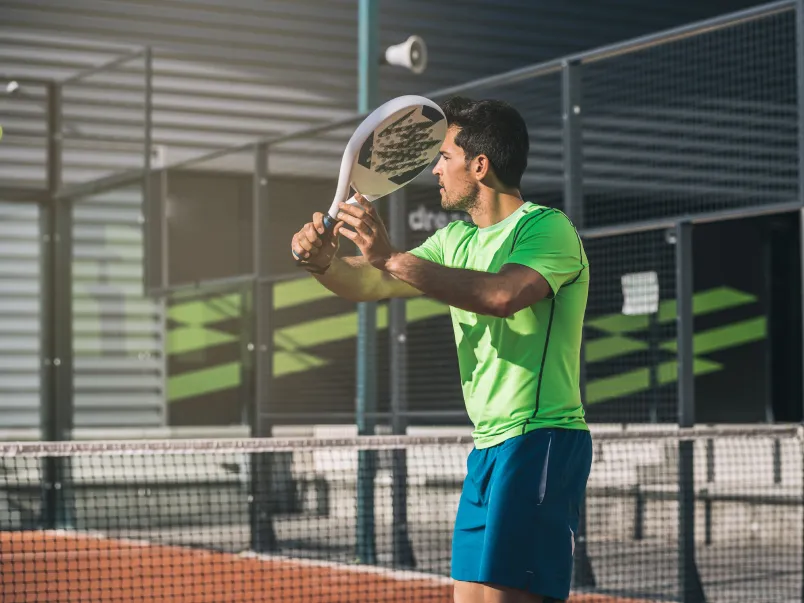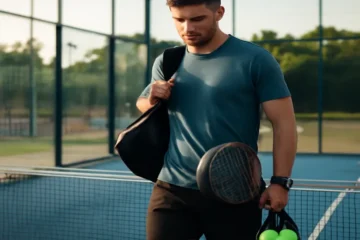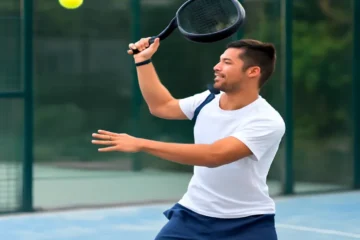Padel is a game of strategy, agility, and precision, where every shot can either make or break your position on the court. If you’re aiming to master this sport, then one technique you cannot overlook is the Bandeja. Often misunderstood and underused, the Bandeja is a game-changer when executed correctly. It’s a defensive yet highly strategic shot, especially when you find yourself at the net and your opponents lob the ball. This guide will break down the mechanics, tactics, and common mistakes of the Bandeja, empowering you to execute it confidently and take control of the net.
Why the Bandeja is Your Key to the Net
Imagine this: you’re at the net, having worked hard to secure your position. Your opponents lob the ball high over your head. You rush to intercept it, but in your haste, you either smash the ball out of the court or, worse, pop it up for an easy winner for your opponents. Sounds familiar? The good news is there’s a solution — the Bandeja.
The Bandeja is your best tool when facing deep lobs. It’s a controlled, defensive overhead shot that allows you to regain your position at the net while maintaining offensive pressure. Whether you’re new to padel or an experienced player, understanding and mastering the Bandeja will elevate your game and prevent you from being pushed back to the baseline.
What is a Bandeja?
At its core, the Bandeja is a defensive overhead shot designed to deal with lobs. In Spanish, “Bandeja” means “tray,” and this visual cue is a helpful way to remember its positioning — it’s like holding a tray above your head.
The Bandeja isn’t just a way to return a lob; it’s about controlling the game. It allows you to maintain your position at the net, prevent a retreat to the baseline, and put pressure on your opponents by landing the ball in difficult-to-reach spots. It’s the perfect alternative to the high-risk, high-reward Smash, especially when dealing with deep lobs or when you’re not in the best position to attack.
Why is the Bandeja Essential?
- Maintains Your Position at the Net: It prevents you from being forced to move back, ensuring that you stay in control of the point.
- Prevents You from Being Forced Back to the Baseline: Unlike a Smash that might push you back, the Bandeja keeps you aggressive, making it a strategic weapon.
- Creates Doubt and Pressure on Your Opponents: A well-executed Bandeja, especially if placed deep, forces your opponents to make difficult returns, leading to mistakes.
- The Fundamental Alternative to the High-Risk Smash: While the Smash is often an attacking shot aimed at finishing the point, the Bandeja is more about controlling the rally.
Part 1: The Foundation – Understanding the Bandeja
1.1. Bandeja vs. Smash: Knowing the Difference
Understanding when to use a Bandeja versus a Smash is crucial. The key differences between these two shots are:
- Goal: The Bandeja is about control and positioning, whereas the Smash is designed to win the point outright with power and aggression.
- Trajectory: The Bandeja has a high, deep trajectory with slice, which helps it clear the net while making it tough for your opponent to attack. The Smash, on the other hand, is a flat, downward shot aimed at finishing the point.
- Contact Point: The Bandeja is executed slightly behind and to the side of your body, while the Smash is taken directly in front and above your head.
- When to Use: The Bandeja is ideal for deep, defensive lobs when you’re positioned at the net, whereas the Smash is more appropriate for short, attackable lobs.
1.2. The Ideal Outcome of a Great Bandeja
When executed correctly, the Bandeja should:
- Land deep in the opponent’s court, ideally near the back glass.
- Bounce low, making it difficult for your opponent to return effectively.
- Allow you and your partner to re-establish your net position, keeping you in control of the rally.
Part 2: The Step-by-Step Execution – Building the Perfect Bandeja
Now that you understand the theory behind the Bandeja, let’s dive into how to execute it properly.
Step 1: The Preparation & Positioning
- The Split Step: The Split Step is the foundation of your movement. It’s the initial hop you make when your opponent is about to hit the ball. It helps you stay balanced and ready to move in any direction.
- Reading the Lob: The key to executing a great Bandeja is reading the lob early. Look for signs that your opponent is going to lob you and prepare yourself mentally for the shot.
- Movement: As the lob comes towards you, use side-shuffling or crossover steps to get into position. Be sure not to turn your back on the net. Your focus should always be on staying in a position to intercept the ball effectively.
Step 2: The Grip and The Backswing
- Grip: The Continental grip (also known as the hammer grip) is crucial for executing the Bandeja correctly. This grip allows you to generate the necessary slice and control for the shot.
- The ‘Tray’ Position: The ideal position for your racket is the “waitress holding a tray” shape. This means the racket head should be up and behind you, ready for the swing.
- Body Position: To hit a successful Bandeja, position your body side-on to the net, with your non-dominant shoulder pointing towards the net. This ensures a clean, controlled shot.
Step 3: The Contact Point
- The Golden Rule: Contact the ball slightly behind and to the side of your body, not directly above your head. This is one of the most important elements of a successful Bandeja.
- Arm Position: Keep your arm bent (as opposed to fully extended as in a Smash). This controlled motion helps you guide the ball with precision.
- Height: Make contact at a comfortable height, ideally around head height. Don’t try to jump for the ball unless it’s absolutely necessary.
Step 4: The Swing and Slice
- The Motion: Your swing should be smooth and forward-and-downward. Focus on a brushing motion that imparts backspin on the ball, ensuring it stays in play and lands deep.
- Creating Slice: The Continental grip and brushing action are key to creating slice. This backspin helps the ball stay in the court and land in a difficult position for your opponent to attack.
- Follow-Through: After contact, your racket should finish across your body, pointing towards the opposite side fence. This ensures control over the direction of the shot.
Part 3: Drills to Groove Your Technique
Now that you understand the mechanics, it’s time to practice. Here are a few drills to help you groove your Bandeja technique:
- Drill 1: The Shadow Swing (No ball): Practice the full motion without a ball to develop muscle memory.
- Drill 2: The Self-Lob: Toss the ball high in the air and practice executing the Bandeja.
- Drill 3: The Partner Lob Drill: Have a partner feed consistent lobs to you, allowing you to practice your technique repetitively.
- Drill 4: The “Bandeja & Net” Drill: Hit a Bandeja and immediately move forward to the net. This drill emphasizes recovery and re-establishing net control.
Part 4: Advanced Tactics and Placement
Where to Aim Your Bandeja?
- The Safe Zone: When in doubt, aim deep to the center of the court. This is a safe, strategic placement that makes it hard for your opponents to return.
- Attacking the Weakness: If you notice your opponent has a weaker backhand or volley, target that side to put them under pressure.
- Changing Direction: Use the side glass for tricky angles. The ball can bounce in unpredictable ways off the glass, making it more difficult for your opponent to read.
- The Vibora (Viper): For advanced players, the Vibora is an aggressive variation of the Bandeja, adding sidespin for a more difficult-to-return shot.
Common Game Situations
- Defending a lob when you’re at the net: The Bandeja is perfect for defending when your opponent tries to lob you at the net.
- Retreating from the net to hit a Bandeja: When you’re forced to move back, use the Bandeja to re-establish your position at the net.
- Hitting a Bandeja from the middle of the court: In doubles, communication with your partner is key when hitting a Bandeja from the middle of the court.
Part 5: Troubleshooting Common Mistakes
Even seasoned players can make mistakes with the Bandeja. Here are a few common errors and how to fix them:
- Mistake 1: Hitting the Ball Out of the Court
Cause: Too much forward motion, not enough slice.
Fix: Focus on the downward brushing motion to keep the ball in play. - Mistake 2: Popping the Ball Up (A “Sitter”)
Cause: Contacting the ball too low or underneath it.
Fix: Be patient and let the ball drop to the correct height for better control. - Mistake 3: Lack of Power or Depth
Cause: Relying only on your arm instead of engaging your core and torso.
Fix: Use your core and rotate your torso into the shot for more power and depth. - Mistake 4: Getting Caught Out of Position
Cause: Failing to recover to the net after the shot.
Fix: Make net recovery a part of your follow-through to stay aggressive.
Conclusion: Patience and Practice
The Bandeja is not just a shot; it’s a strategic weapon that allows you to dominate the net and maintain control over the point. While it may feel unnatural at first, with consistent practice and patience, it will become a reliable and essential part of your padel arsenal. Keep practicing, stay patient, and soon enough, you’ll be able to execute this powerful defensive move with ease and confidence.
FAQs
1. What is a Bandeja in padel?
A Bandeja is a controlled, defensive overhead shot used in padel to respond to high lobs, regain your position at the net, and apply pressure on your opponents. It’s a strategic alternative to the more aggressive smash, offering better control and positioning.
2. When should I use the Bandeja in padel?
The Bandeja is most effective when defending against a deep lob while at the net. It allows you to stay aggressive and control the rally, unlike the smash, which is typically used for attacking short lobs.
3. What is the difference between the Bandeja and the Smash?
The Bandeja focuses on control and positioning, with a high, deep trajectory and slice, making it difficult for your opponent to attack. In contrast, the Smash is an aggressive shot aimed at finishing the point with power, usually executed when the lob is short and attackable.
4. How do I execute a perfect Bandeja?
To execute a perfect Bandeja, follow these key steps:
- Prepare with a side-on stance and the Continental grip.
- Position the racket like a “tray” behind you.
- Make contact slightly behind and to the side of your body.
- Use a smooth, downward brushing motion to impart slice and control the ball’s trajectory.
5. What are the common mistakes when hitting a Bandeja?
Some common mistakes include hitting the ball out of the court (due to lack of slice), popping the ball up (contacting it too low), and lacking power or depth (not engaging the core). Proper technique, patience, and body movement are key to correcting these mistakes.
6. How can I improve my Bandeja?
Practice is essential! Start with shadow swings and self-lobs to perfect your form. You can also partner with someone to feed consistent lobs and work on your timing and positioning. Drills like the “Bandeja & Net” drill will help you recover quickly and stay aggressive.




